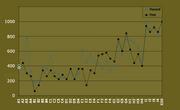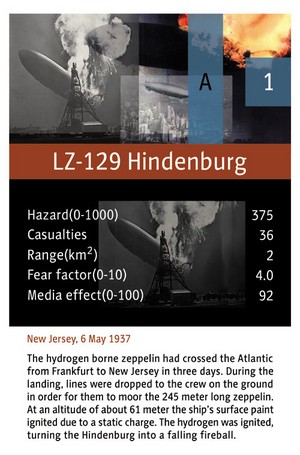|

The hydrogen-borne Zeppelin had crossed the Atlantic from Frankfurt to New Jersey in three days. Aboard the craft were 36 passengers and 61 crewmembers. The Zeppelin was delayed by a storm and did not reach the Lakehurst airport in New Jersey until late in the afternoon on the 6 May 1937.
At 7 p.m. the landing began: lines were dropped to the crew on the ground in order for them to moor the 804-foot long Zeppelin. During the landing operation the airship burst into flames at an altitude of about 200 feet. The ship�s surface paint ignited due to an electric discharge; then the hydrogen was ignited, turning the Hindenburg into a falling fireball.
The ship started descending the rear end first, allowing for some of the passengers to jump from the burning craft. Others ran out of the ship once it hit the ground. Still, 35 people died.
After the accident, the Zeppelin Company swore never to use hydrogen again, as the fuel was blamed for the fire. Instead, helium could be used, but USA, who had the monopoly on helium, refused to sell it to the Germans, who planned on using helium-driven Zeppelins for military uses. The Hindenburg was thus the last large-scale zeppelin project for 60 years.
New research has shown that hydrogen was probably not the cause of the fire. Instead, researchers refer to the phenomenon �precipitation static� � that is, when a static charge is created due to the rubbing of raindrops and air particles. It also turned out that The Hindenburg�s outer paint layer was highly flammable. When the Hindenburg flew through the storm the paint caught this electric charge, which caused the fire.
Researchers at the German inquiry commission probably knew about the role of the flammable outer paint layer, but because of insurance considerations, this information was never published.
Comment this page
 
Links and references:
Explaining precipitation static:
http://www.owlnet.rice.edu/~anguyen/univ/howitigni...
Speculations about why the role of the paint layer never was published:
http://www.owlnet.rice.edu/~anguyen/univ/howitigni...
The new theory of Dr. Addison Bain, a retired NASA engineer:
http://www.dwv-info.de/pm/hindbg/hbe.htm#oben
FBI investigation:
http://foia.fbi.gov/hindburg.htm
Case report from the Regulation and Enforcement Division of the Bureau of Air Commerce:
http://www.thirdreichforum.com/viewtopic.php?t=880...
National Hydrogen Association:
http://www.hydrogenus.com/advocate/ad22zepp.htm
|



